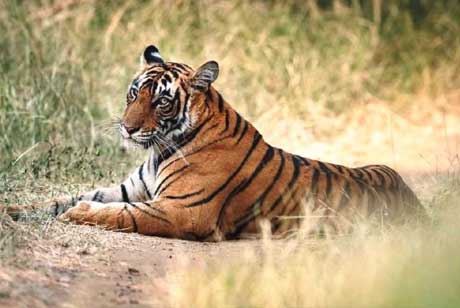Stands royally on the edge of Ranthambore national park, The Ranthambore Fort is the world heritage site situated in the Sawai Madhopur district of Rajasthan. The fort got its name from the two adjacent hills Rann and Thambore. It is built on the Thambore hill, 481 meters above the sea level, overlooking the hills of Rann. The fort has witnessed the numerous battles of every possible magnitude and has seen the changing dynamics of imperial era of Rajasthan. The fort is situated in the vicinity of the Vindhya and Aravali hill ranges and offers amazing views of a large forest, valleys and lakes. The Ranthambore national park named after this fort, which situated in the forest.
The history of the Fort goes back to around the 10th century and ever since it has been built, the fort caught the eyes of various mighty rulers who tried to capture this fort. This fort was strategically placed and has been considered as the feather in the crown of rulers who conquered it. The Ranthambore Fort was considered as invincible when built. Though later it was conquered few times but was very tough to conquer. Having been at the center of the historical developments in Rajasthan, The fort has witnessed the glorious days and heroism of Hammir dev of the mighty Chauhan dynasty. The fort was under the Maharajas of Jaipur until the Jaipur kingdom became the part of the Indian Dominion.


The fort is spread over an area of around 4 sq. km with the length of the wall of the fort is about 7km. There are many ruins of houses, temples, palaces and step-wells can be seen in and around the fort. The long enormous wall that surrounds the fort has been built with the massive stones. Once considered invincible, the wall has enough towers and bastions, which were used to fortify the fort when attacked. The main access path to the fort passes through the narrow valley and had four fortified gateways. Among the four gates, only one gate named Misradhara gate is survived the numerous wars and plight of time, and still standing here. The ruins of buildings such as Hammir Kachahari, Hammir Palace, Battis khamba Chhatri, Badal Mahal, Phansi Ghar and many others, which were the pride of the fort, can be seen inside the fort.
The fort has many tombs, temples, mosques, step-wells and gates, mostly turned into the ruins, but few are still standing here, even after a long era has passed since it had been built. There are three main temples in the fort, which are visited and worshiped. Among them, the Trinetra Ganesh temple is the most famous temple and is located just inside the main entry gate. It attracts a large chunk of devotees from the nearby towns and villages. During the Ganesh festival, the temple sees thousands of Ganesh devotees from all over the country. This temple has one interesting aspect, which is the invitation mail to Lord Ganesh. People used to send mail to invite Lord Ganesh if any auspicious ceremony is going to take place in their life, mostly the wedding invitation. The temple got many such letters delivered by the postman of the area.
The scenic beauty around the fort is very enchanting to watch from the fort. Every corner of the fort provides you the enchanting overlooking views of hills, valleys, lakes and the 5000-hectare wide national park. The Ranthambore Fort is a place which shouldn't be missed if you are visiting Ranthambore. Wednesday is known to be the day of the Lord Ganesha and is the best day to visit this fort as local peoples dressed in their local dresses visit to pray at the Ganesha temple.